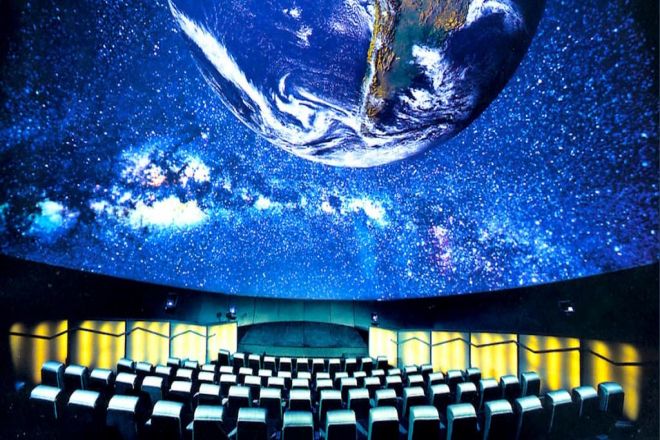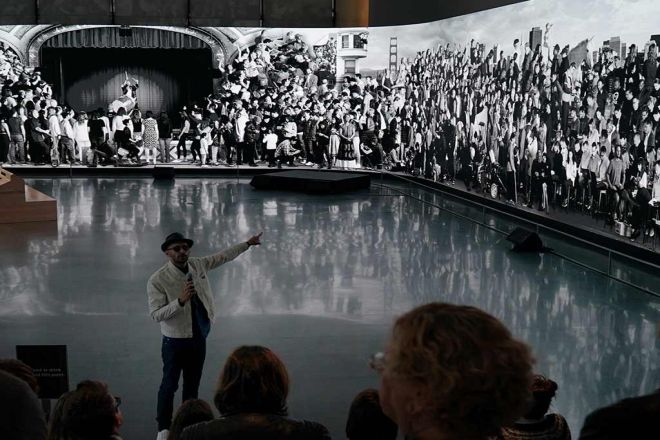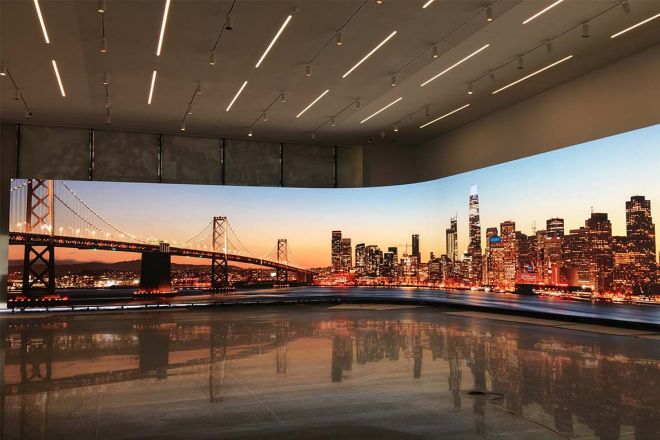Introducción

Imagina que cuando entras en un espacio rodeado de pantallas ledLas escenas históricas reaparecen ante ti al instante, como si estuvieras en un palacio hace miles de años o hubieras vivido en primera persona una emocionante batalla histórica. No se trata solo de un festín visual, sino también de un toque espiritual y un profundo diálogo cultural.
Este artículo le permitirá comprender más profundamente cómo las pantallas LED inmersivas están transformando los métodos de exhibición de museos y revelar cómo utiliza el poder de la tecnología para dar nueva vida al patrimonio cultural antiguo.
1. Descripción general de la tecnología de pantalla LED inmersiva

Las pantallas LED inmersivas utilizan tecnología avanzada de control de software para lograr una unión perfecta entre múltiples unidades de visualización.
Esto significa que, ya sea que se trate de una enorme pantalla curva o de un espacio tridimensional circundante, se puede presentar un efecto visual continuo y uniforme como si todo el espacio estuviera rodeado de imágenes y contenido de vídeo. Al mismo tiempo, el software también admite la reproducción y el ajuste en tiempo real de contenido dinámico, lo que garantiza que el público pueda sumergirse en un festín visual fascinante y en constante cambio.
En eventos a gran escala, como transmisiones en vivo de eventos deportivos como los Juegos Olímpicos y la Copa del Mundo, las pantallas LED brindan una experiencia de visualización sin precedentes a la audiencia con su gran tamaño, calidad de imagen clara y efectos visuales impactantes.
En exhibiciones comerciales, ya sea publicidad en ventanas, Centros comerciales, paredes de exhibición en exhibiciones, o pantallas de fondo en etapasLas pantallas LED han atraído innumerables miradas con sus métodos de visualización flexibles y creativos.
Son estos casos de aplicación exitosos los que han sentado una base técnica y de mercado sólida para la aplicación de pantallas LED en el ámbito de los museos.
Los museos comenzaron a darse cuenta de que, al introducir la tecnología de pantallas LED inmersivas, podían romper las limitaciones de las exposiciones tradicionales y ofrecer al público una experiencia de visualización más vívida, intuitiva e interactiva. Como resultado, ha surgido silenciosamente una revolución en los museos impulsada por la tecnología y basada en la cultura.
2. La experiencia innovadora de los museos LED inmersivos
1) Reproducción de escenas, la historia “cobra vida”
En los museos inmersivos con tecnología LED, los límites de la historia se rompen por completo. Mediante el uso de pantallas LED de alta definición, los museos pueden construir escenas históricas realistas.
Ya se trate de los antiguos campos de batalla con llamas furiosas o de los magníficos banquetes palaciegos, parece que hayan renacido. Cuando el público está en ellos, no solo puede ver la belleza de los detalles de estas escenas, sino que también siente el peso histórico que conllevan.
Además, el museo también combina inteligentemente elementos multisensoriales como el sonido y el olfato, como simular el sonido de los cascos de los caballos y las espadas en el campo de batalla o la fragancia de las flores y el vino en el palacio, lo que mejora aún más la sensación de inmersión, haciendo que el público parezca haber viajado realmente a través del tiempo y el espacio y haberse comunicado cara a cara con eventos y personajes históricos.
2) Experiencia interactiva, doble sentido de participación.
El museo LED inmersivo no es sólo un lugar de observación, sino también un espacio interactivo en el que el público puede participar.
El museo ha diseñado una variedad de enlaces interactivos, como tocar la pantalla para activar una historia específica, lo que permite a la audiencia elegir la dirección de exploración según sus propios intereses o afectar los cambios en la imagen a través de las acciones de la audiencia, como agitar para controlar el cambio y el zoom de la imagen, etc., lo que mejora enormemente la participación y el interés de la audiencia.
Además, el museo también utiliza tecnología AR (realidad aumentada)/VR (realidad virtual) combinada con pantallas LED para crear una experiencia interactiva más colorida.
El público puede usar equipos de realidad virtual para ingresar a la escena histórica virtual y explorarla o usar tecnología de realidad aumentada para superponer elementos virtuales en el mundo real y lograr una maravillosa experiencia de combinación de lo virtual y lo real.
3) Exhibición de arte, creatividad ilimitada.
El museo inmersivo de LED es también un nuevo escenario para la creación artística. Los artistas utilizan pantallas LED como medio creativo para crear sorprendentes obras de luz y sombra a través de los cambios de luz y sombra y la combinación de colores.
Estas obras no sólo muestran la perspectiva única y el talento creativo de los artistas, sino que también añaden una fuerte atmósfera de arte moderno al museo.
Al mismo tiempo, los cambios dinámicos de luz y sombra de la pantalla LED también pueden mostrar delicadamente la belleza de los detalles y la expresión emocional de la obra de arte, como resaltar el sentido tridimensional de la escultura a través del contraste de luz y oscuridad de luz y sombra, o transmitir el color emocional de la pintura a través del cambio gradual de color.
Esta nueva forma de exhibición no sólo mejora la experiencia estética del público sino que también hace que la obra de arte en sí brille con nueva vitalidad.
3. Análisis de caso de museos inmersivos con LED


1) Exposición inmersiva en pantalla LED de la cultura de la dinastía Han de Mawangdui en el Museo de Hunan, China
Con motivo del 50º aniversario de la excavación arqueológica de la Tumba Han de Mawangdui, el Museo de Hunan, China, junto con la Biblioteca Digital de China y el Laboratorio de Arte Chino de la Universidad de Harvard, lanzaron conjuntamente la “Exposición digital inmersiva de arte de vida-cultura de la dinastía Han de Mawangdui”.
Esta exposición no es sólo un homenaje al importante patrimonio cultural de la Tumba Han de Mawangdui, sino también una nueva presentación del encanto de la cultura antigua a través de medios científicos y tecnológicos modernos, ofreciendo al público una fiesta cultural a través del tiempo y el espacio.
1). Exhibición Características y aspectos destacados
- Experiencia inmersiva:
La exposición hace uso completo de la tecnología de pantalla LED inmersiva y reproduce la estructura de la tumba, el diseño de las reliquias culturales y las ricas reliquias culturales desenterradas de la Tumba Han de Mawangdui a través de tecnologías multimedia de vanguardia, como la proyección tridimensional de escaneo de reliquias culturales de ultra alta definición y 3D a simple vista.
El público parece viajar a través del tiempo y el espacio, y estar en la corte de la dinastía Han occidental, y experimentar personalmente el estilo y la atmósfera cultural de esa época.
- Visualización multidimensional:
La exposición consta de tres temas artísticos: “tiempo y espacio”, “yin y yang” y “vida”, que muestran plenamente los logros artísticos y la esencia ideológica de la cultura de la dinastía Han de Mawangdui.
Entre ellos, la sección “Tiempo y espacio” muestra la estructura de la cámara del ataúd y el diseño general de la Tumba Han de Mawangdui a través de una narrativa multimedia; la sección “Yin y Yang” interpreta vívidamente el concepto de “dispersión y reunión del yin y el yang” en la Tumba Han de Mawangdui a través de proyección vertical y tecnología de transición de imágenes digitales.
La sección “vida” utiliza pantallas de bolas LED inmersivas y un diseño gráfico dinámico interactivo, lo que permite a la audiencia sentirse como si estuvieran en la ceremonia “de la tierra al cielo” representada en la pintura de seda en forma de T de la Tumba Han de Mawangdui, y sentir profundamente el romance de la transformación y la ascensión de la vida.
- Integración de lo académico y la tecnología:
La exposición integra recursos académicos globales, combina los resultados de investigación más vanguardistas de la comunidad académica global sobre la cultura de la dinastía Han de Mawangdui y explora profundamente la filosofía de vida de la “armonía entre el hombre y la naturaleza” en la cultura de la dinastía Han llevada por la Tumba Han de Mawangdui.
Al mismo tiempo, la exposición también utiliza tecnologías multimedia de vanguardia, como el arte de algoritmos generativos y pantallas de bolas LED con formas especiales, para brindar al público una experiencia cognitiva profunda y un impacto artístico de la visión temprana de la vida cósmica de China.
1.2) Efecto e impacto de la exposición
Desde su apertura, la exposición ha atraído a un gran número de visitantes con su método de exhibición único y su profunda connotación cultural.
La audiencia dijo que a través del uso de la tecnología de pantalla LED inmersiva, sintieron el encanto de la cultura de la dinastía Han de Mawangdui de manera más intuitiva y también tuvieron una comprensión más profunda de la cosmología y la vida de la antigua China.
Además, la exposición ha atraído la atención generalizada de la comunidad académica y de todos los sectores de la vida y ha hecho contribuciones positivas a la promoción y difusión de la excelente cultura tradicional de China.


2) Museo de Arte Moderno de San Francisco, Estados Unidos
En el Museo de Arte Moderno de San Francisco, un espacio museístico inmersivo LED sin precedentes está atrayendo la atención de los amantes del arte de todo el mundo.
Este espacio único se centra en la obra maestra “San Francisco Chronicles” del artista JR y utiliza tecnología avanzada de pantalla LED e instalaciones interactivas multimedia para crear una fiesta de arte sin precedentes.
Tan pronto como los visitantes ingresan a este inmersivo museo LED, quedan inmediatamente rodeados de luces y sombras deslumbrantes.
La pared de video LED curvada de 107 pies de alto es como una pantalla gigante que rodea el espacio de 90 grados y envuelve completamente a la audiencia en la historia y la realidad de San Francisco construida por luces y sombras.
Esta pieza, con su paso de píxeles extremo de 6 mm, presenta una calidad de imagen sorprendente y delicada, haciendo que cada detalle sea vívido.
“San Francisco Chronicles” no es solo un festín visual, sino también un toque del alma. El artista JR utiliza imágenes y sonidos cuidadosamente seleccionados para mostrar vívidamente los diversos rostros y el profundo legado de la ciudad de San Francisco.
Desde calles concurridas hasta parques tranquilos, desde reliquias históricas hasta edificios modernos, cada obra parece contar la historia de San Francisco, permitiendo a los visitantes viajar a través del tiempo y el espacio y experimentar los cambios y el crecimiento de la ciudad de primera mano.
Además del disfrute visual y auditivo, este museo inmersivo con tecnología LED también se centra en las experiencias interactivas con los visitantes. A través de innovadores dispositivos interactivos multimedia, los visitantes pueden participar en la creación y presentación de obras y mantener diálogos e intercambios con artistas de todo el tiempo y el espacio.
Esta interactividad no sólo mejora la sensación de participación y experiencia de los visitantes, sino que también les permite comprender y sentir más profundamente la connotación y el encanto de las obras de arte.
4. Desafíos a los que nos enfrentamos

1). Análisis de desafíos
Si bien las perspectivas de aplicación de la tecnología de pantalla LED inmersiva en los museos son amplias, su camino de desarrollo no es sencillo y aún enfrenta muchos desafíos:
- Alto costo de construcción:
Para construir un museo inmersivo con tecnología LED se necesita una gran cantidad de pantallas LED, equipos de reproducción de alto rendimiento y sistemas de control complejos. Los costos de adquisición e instalación de estos equipos son elevados, lo que supone una gran carga para muchos museos.
- Dificultad de mantenimiento técnico:
El sistema de pantalla LED inmersiva involucra múltiples campos técnicos, incluida la tecnología de pantalla LED, la tecnología de procesamiento de imágenes, la tecnología de empalme de múltiples pantallas, etc. Su mantenimiento y conservación requieren técnicos profesionales. Una vez que ocurre una falla, la dificultad y el costo de la reparación son relativamente altos.
- Umbral de creación de contenido:
Para aprovechar al máximo el potencial de las pantallas LED inmersivas, es necesario producir contenidos de alta calidad y altamente interactivos. Sin embargo, la creación de dichos contenidos requiere un trabajo en equipo interdisciplinario, que incluya historiadores, artistas, técnicos, etc., con un umbral de creación alto y un largo ciclo de producción.
2) Estrategia de respuesta
Frente a los desafíos antes mencionados, podemos proponer las siguientes estrategias de respuesta:
- Apoyo gubernamental:
El gobierno puede alentar a los museos a introducir la tecnología de pantallas LED inmersivas mediante subsidios financieros, incentivos fiscales y otras políticas. Al mismo tiempo, el gobierno también puede establecer fondos especiales para apoyar la investigación, el desarrollo y la innovación de tecnologías relacionadas.
- Innovación tecnológica:
Los fabricantes de tecnología deben seguir aumentando la inversión en I+D, mejorar los indicadores de rendimiento de las pantallas LED y reducir los costes de producción. Al mismo tiempo, deben explorar soluciones de mantenimiento de sistemas más inteligentes y convenientes para reducir la carga operativa de los museos.
- Cooperación transfronteriza:
Los museos deberían fortalecer la cooperación con universidades, instituciones de investigación científica, empresas culturales y otras instituciones para promover conjuntamente la creación y el desarrollo de contenido de exhibición inmersiva. A través de la cooperación transfronteriza, podemos reunir recursos ventajosos de todas las partes y mejorar la calidad y la eficiencia de la creación de contenido.
Conclusión
Al recordar el historial de aplicaciones de las pantallas LED inmersivas en museos, no podemos evitar maravillarnos ante el potencial ilimitado de esta tecnología.
No sólo rompe los límites de las exposiciones tradicionales de los museos, permitiendo presentar la historia y la cultura al público de una forma más vívida e intuitiva; también estimula el entusiasmo del público por participar a través de un diseño interactivo y experiencial para que puedan sentir profundamente el encanto y el poder de la cultura mientras disfrutan de un festín visual.
Sin embargo, también debemos ser conscientes de que la aplicación de pantallas LED inmersivas en museos aún enfrenta muchos desafíos, como los altos costos de construcción, la complejidad del mantenimiento técnico y los requisitos innovadores para la creación de contenido. Pero son estos desafíos los que indican la dirección de nuestros esfuerzos futuros.
Finalmente, si quieres saber más sobre las pantallas LED, Por favor póngase en contacto con nosotros.
